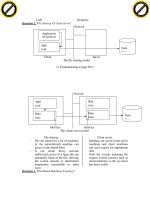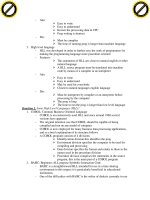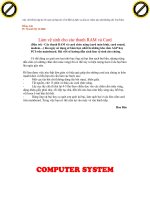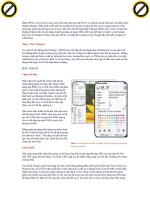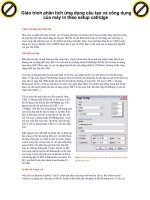Giáo trình phân tích ứng dụng cấu tạo và công dụng của máy in theo setup catridge p6 pdf
Bạn đang xem bản rút gọn của tài liệu. Xem và tải ngay bản đầy đủ của tài liệu tại đây (214.37 KB, 5 trang )
- The base is ten – there are 10 different symbols, the digits 0, 1, 2,
etc upto 9
- To represent value less than ten involves only one digit larger values need
two or more digits
Binary system
- The base must be two, with only the digits 0 and 1 available
- To show values of two or ever require two or more binary digits
Octal system
- Octal system has eight as its base, it uses the symbol 0, 1, 2 up to 7 only
- Two or more digits are needed for values of eight and above
Hexadecimal system(hex)
- Hexadecimal system has sixteen as its base, it use the symbols 0, 1, 2 ,9
& A, B, C, D, E, F, to stand for the “digits” ten, eleven, twelve, thirteen,
fourteen, fifteen.
Question 2. Converting from Bases To Bases?
1. Change the decimal
- Binary:
Eg. (2559) 10
2559 1
1279 1
639 1
319 1
159 1
79 1 (2559)
10
= (10111111111)
2
39 1
19 1
9 1
4 0
2 1
0 0
- Octal:
7690 8
49 96,1 8
10 16 120 8
40 15 8
(7690)
10
= (17012)
8
- Hexadecimal:
6396 16
159 399 16
156 79 24 16
2
1
0
7
11
1221
15
81
11
Click to buy NOW!
P
D
F
-
X
C
h
a
n
g
e
V
i
e
w
e
r
w
w
w
.
d
o
c
u
-
t
r
a
c
k
.
c
o
m
Click to buy NOW!
P
D
F
-
X
C
h
a
n
g
e
V
i
e
w
e
r
w
w
w
.
d
o
c
u
-
t
r
a
c
k
.
c
o
m
C F
(6369)
10
= (CF81)
16
2. Convert to others from binary
- To decimal
(101010)
2
(?)
10
1.2
5
+ 0.2
4
+ 1.2
3
+ 0.2
2
+ 1.2
1
+ 0.2
0
= 42
(101010)
2
= (42)
10
- To octal
100101101
1
st
step change into denary
= 1.2
8
+ 1.2
5
+ 1.2
3
+ 1.2
2
+ 1.2
0
= 256 + 32 + 8 + 4 + 1
=(301)
10
2
nd
step: convert to octal
301 8
61 37 8
(301)
10
= (455)
8
(100101101)
2
= (455)
8
- To hexadecimal
110111011011
1
st
step
= 1.2
11
+ 1.2
10
+ 1.2
8
+ 1.2
7
+ 1.2
6
+ 1.2
4
+ 1.2
3
+ 1.2
1
+ 1.2
0
= 2048+ 1024 + 256 + 158 + 64 + 16 + 8 + 2 + 1
= (3547)
10
2
nd
step
3547 16
384 221 16
27 61
(3547)
10
= (CCA)
16
(110111011011)
2
= (CCA)
16
3. Convert into binary and display the answer in normalized exponential form
247 1
123 1
61 1
30 1
5
5
4
11
13
13
Click to buy NOW!
P
D
F
-
X
C
h
a
n
g
e
V
i
e
w
e
r
w
w
w
.
d
o
c
u
-
t
r
a
c
k
.
c
o
m
Click to buy NOW!
P
D
F
-
X
C
h
a
n
g
e
V
i
e
w
e
r
w
w
w
.
d
o
c
u
-
t
r
a
c
k
.
c
o
m
15 1
7 1
3 1
1 1
0 1
(247)
10
= (11110111)
2
= 0. 1111011 x 2
normalized exponential form
Question 3. Integer and Floating – point arithmetic?
1. Floating – point Addition
a. (0.1011 x 2
5
) + (0.1001 x 2
5
)
= (0.1011 + 0. 1001) x 2
5
= 1.0100 x 2
5
= 0.10100 x 2
6
b. (0.1001 x 2
3
) + (0.1110 x 2
5
)
= (0.001001 x 2
5
) + (0.1110 x 2
5
)
= (0.001001 + 0.111000) x 2
5
= 1.000001 x 2
5
= 0.1000 x 2
6
(here have truncation)
(0.1000001 x 2
6
)
2. Floating – point subtraction
a. (0.1110 x 2
7
) – (0.1100 x 2
7
)
= 0.0010 x 2
7
= 0. 10 x 2
5
b. (0.1001 x 2
8
) – ( 0.1000 x 2
5
)
= (0.1001 x 2
8
) – ( 0.0001 x 2
8
)
= 0.1000 x 2
8
3. Floating – point multiplication
a. (0.1010 x 2
3
) x (0.1100 x 2
3
)
= (0.1010 x 0.1100) x 2
6
= 0.01111 x 2
6
= 0.1111 x 2
5
b. (0.11110 x 2
3
) x ((0.01011) x 2
4
)
= (0.11110 x 0. 01011) x 2
7
= 0.001111 x 2
7
= 0.1111 x 2
5
4. Floating – point division.
a. (0.11010 x 2
6
) : (0.001 x 2
6
)
= (0.11010 x 2
6
) : (1 x 2
3
)
= 0.1101 x 2
6
: 1x 2
3
= 0.1101 x 2
3
b. (0.110111 x 2
6
) : (0.1001 x 2
4
)
= (0.110111 : 0.1001) x 2
2
= (1101.11 : 1001) x 2
2
= 1.100001 x 2
2
= 0.1100001 x 2
3
Chapter 3: TYPES OF INSTRUCTION AND ADDRESSING.
Click to buy NOW!
P
D
F
-
X
C
h
a
n
g
e
V
i
e
w
e
r
w
w
w
.
d
o
c
u
-
t
r
a
c
k
.
c
o
m
Click to buy NOW!
P
D
F
-
X
C
h
a
n
g
e
V
i
e
w
e
r
w
w
w
.
d
o
c
u
-
t
r
a
c
k
.
c
o
m
Question 1. Types of instructions used in CS?
1. Arithmetic instructions.
Arithmetic instructions include directives to the computers to perform additions,
subtraction, multiplications, divisions and exponentiations.
2. Input/ output instructions.
They direct the computer to read data values from the specified input devices into the
main store for processing.
They also include instructions to write the contents of memory locations holding the
result of processing to a specified output device.
3. Decision or control instructions.
Most data processing application will contain situations where alternative calculations
or procedures will have to be executed based on the result of condition tests carried
out.
4. Data handling instructions
They include the copying of the content of one memory location to another or setting
a memory locations to an initial value.
Also include the management or insertion of characters into data items
Examples of such instructions include branch instructions, jump instruction & stop
instruction.
Question 2. Types of addressing?
1. Direct addressing
The operands of each machine instructions is used to retrieve the data
2. Indirect addressing
The operands is used to specify the memory address which contains the address of the
data to be processed
Op – code
OP – CODE
OPERAND OP – CODE OPERAND
12345
Data item
12345
Data item
Main storage
Direct addressing
Indirect addressing
3. Indexed addressing
- The main applications of this type of addressing technique is to enable to
access of sequential locations in memory that are adjacent to each other
- Each adjcent memory address has value n+1, where n is the address of the
previous location
- When the first of the location have been accessed, the next memory
location in sequence is accessed by simply increasing the add of the
present location by 1 & using accessing it
Click to buy NOW!
P
D
F
-
X
C
h
a
n
g
e
V
i
e
w
e
r
w
w
w
.
d
o
c
u
-
t
r
a
c
k
.
c
o
m
Click to buy NOW!
P
D
F
-
X
C
h
a
n
g
e
V
i
e
w
e
r
w
w
w
.
d
o
c
u
-
t
r
a
c
k
.
c
o
m
- The starting address of the series of locations is specified in the operand of
the instruction
- In order to access the next location in sequence, the content of the index
register is increased by 1 a added to the opreand address
- This is done repeatedly until the last memory location in the series is
processed
Indexed addressing.
OP – CODE OPERAND
Index Register
Chapter 4: PROGRAMMING LANGUAGES.
Question 1. Program and level of language?
Program is group of constructions that is linked together to perform specific task. It’s
necessary for a computer program to be written in a “PL” because at a computer
program is created by a programing using a sys analyst’s specification of the job in
the hand.
1. Machine language
- ML is the set of bit(0,1) that can performed considered by CPU
- Ads
fast
short prog
store in small memory
- Dis
difficult to understand & remember its code
takes a lot of time to programming
difficult to use
2. Low level language
- LLL is used to dercribe exactly procedure of performance of CPU at
certain time
- Features:
Instruction is written by natrural English or natural
language
More powerful and so the prog is shortest
Need less instruction
Is a one to one relationship between the written instruction
and the machine instructions
It’s instruction tend to be machine. It runs in OS
Data 1 Data 2 Data 3 Data 4
Click to buy NOW!
P
D
F
-
X
C
h
a
n
g
e
V
i
e
w
e
r
w
w
w
.
d
o
c
u
-
t
r
a
c
k
.
c
o
m
Click to buy NOW!
P
D
F
-
X
C
h
a
n
g
e
V
i
e
w
e
r
w
w
w
.
d
o
c
u
-
t
r
a
c
k
.
c
o
m

